AMD FX-8320E CPU Review: The Other 95W Vishera
by Ian Cutress on January 13, 2015 10:00 AM ESTCPU Benchmarks
The dynamics of CPU Turbo modes, both Intel and AMD, can cause concern during environments with a variable threaded workload. There is also an added issue of the motherboard remaining consistent, depending on how the motherboard manufacturer wants to add in their own boosting technologies over the ones that Intel would prefer they used. In order to remain consistent, we implement an OS-level unique high performance mode on all the CPUs we test which should override any motherboard manufacturer performance mode.
HandBrake v0.9.9: link
For HandBrake, we take two videos (a 2h20 640x266 DVD rip and a 10min double UHD 3840x4320 animation short) and convert them to x264 format in an MP4 container. Results are given in terms of the frames per second processed, and HandBrake uses as many threads as possible.
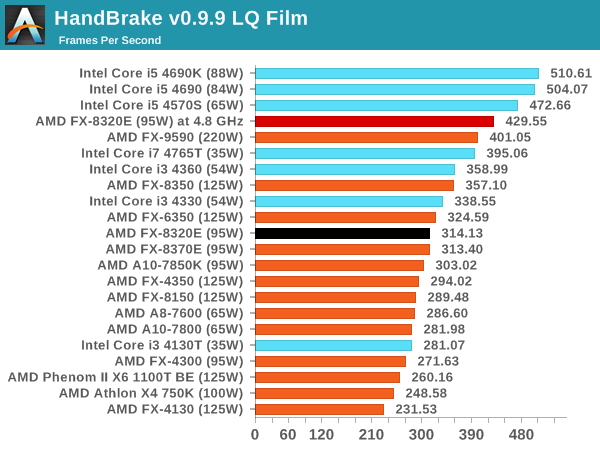
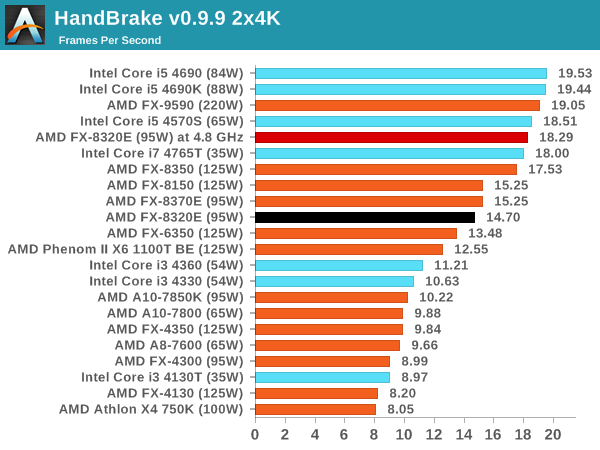
For Low Quality conversion, the 8320E has trouble keeping up with the full-fat i3, but beats them by a good margin when the frame sizes open up.
Dolphin Benchmark: link
Many emulators are often bound by single thread CPU performance, and general reports tended to suggest that Haswell provided a significant boost to emulator performance. This benchmark runs a Wii program that raytraces a complex 3D scene inside the Dolphin Wii emulator. Performance on this benchmark is a good proxy of the speed of Dolphin CPU emulation, which is an intensive single core task using most aspects of a CPU. Results are given in minutes, where the Wii itself scores 17.53 minutes.
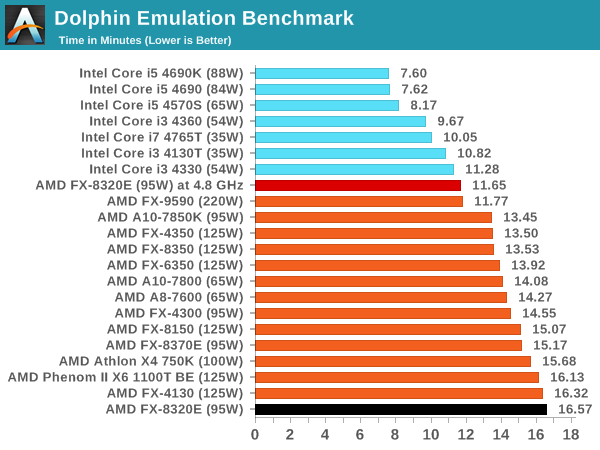
Dolphin historically prefers high IPC single core performance, which the 8320E is lacking.
WinRAR 5.0.1: link
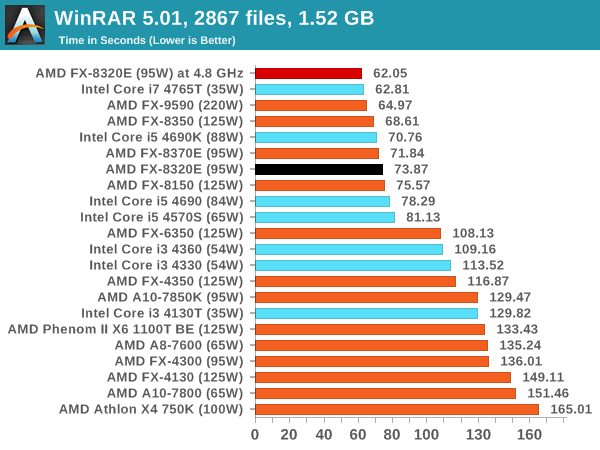
The eight threads of the FX-8000 series show through here, beating all the i3 and some of our i5 parts.
PCMark8 v2 OpenCL
A new addition to our CPU testing suite is PCMark8 v2, where we test the Work 2.0 suite in OpenCL mode.
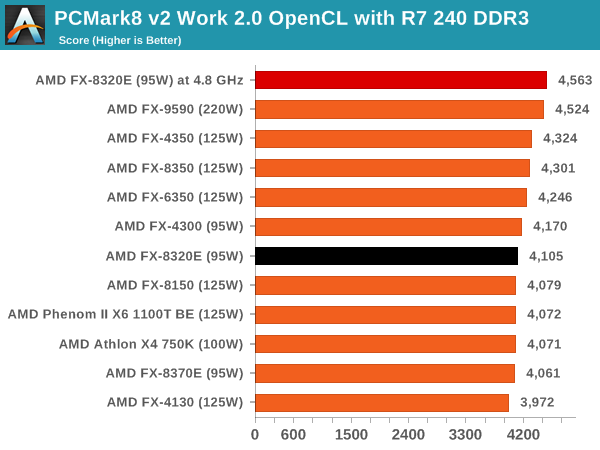
Hybrid x265
Hybrid is a new benchmark, where we take a 4K 1500 frame video and convert it into an x265 format without audio. Results are given in frames per second.
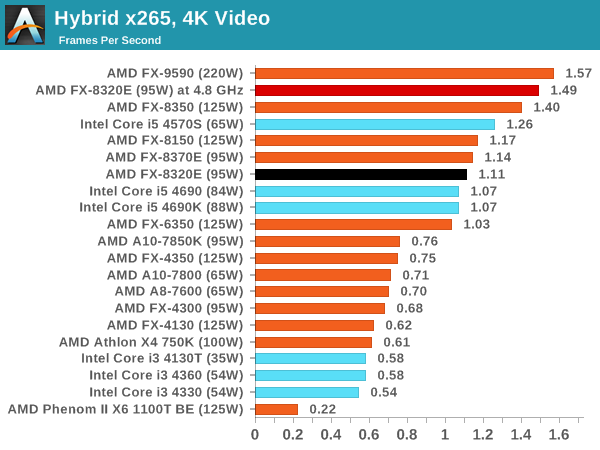
For x265 conversion those extra threads end up highly beneficial for the FX-8320E, nudging inbetween our i5 data.
3D Particle Movement
3DPM is a self-penned benchmark, taking basic 3D movement algorithms used in Brownian Motion simulations and testing them for speed. High floating point performance, MHz and IPC wins in the single thread version, whereas the multithread version has to handle the threads and loves more cores. For a brief explanation of the platform agnostic coding behind this benchmark, see my forum post here.
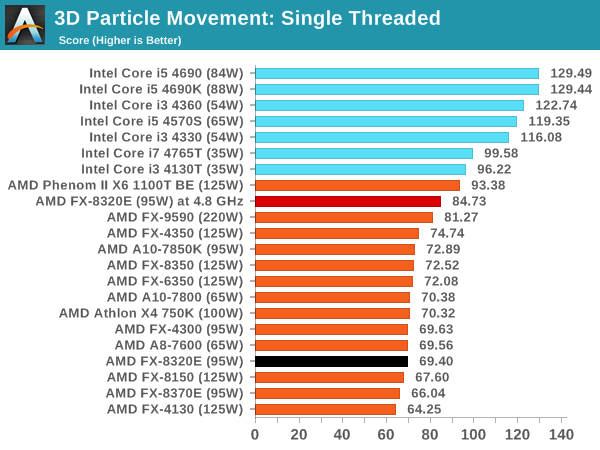
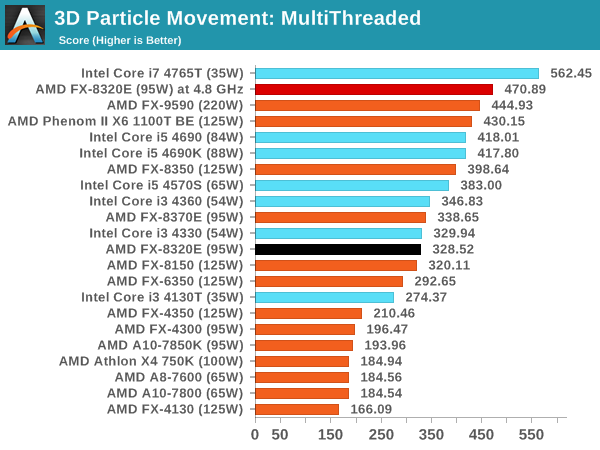
While single thread performance is behind, the overclocked FX-8320E storms ahead of our FX-9590 results.
FastStone Image Viewer 4.9
FastStone is the program I use to perform quick or bulk actions on images, such as resizing, adjusting for color and cropping. In our test we take a series of 170 images in various sizes and formats and convert them all into 640x480 .gif files, maintaining the aspect ratio. FastStone does not use multithreading for this test, and results are given in seconds.
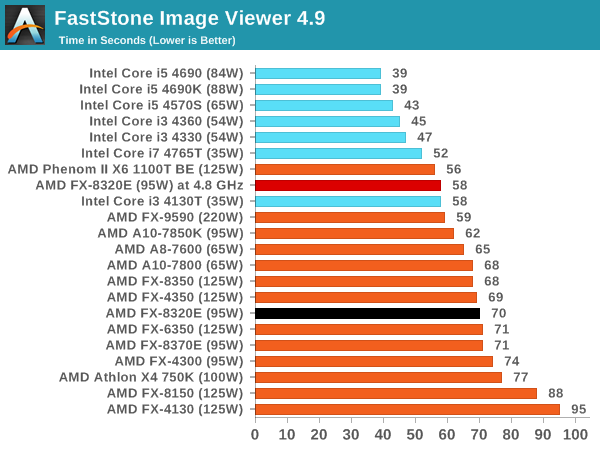
Web Benchmarks
On the lower end processors, general usability is a big factor of experience, especially as we move into the HTML5 era of web browsing. For our web benchmarks, we take four well known tests with Chrome 35 as a consistent browser.
Sunspider 1.0.2
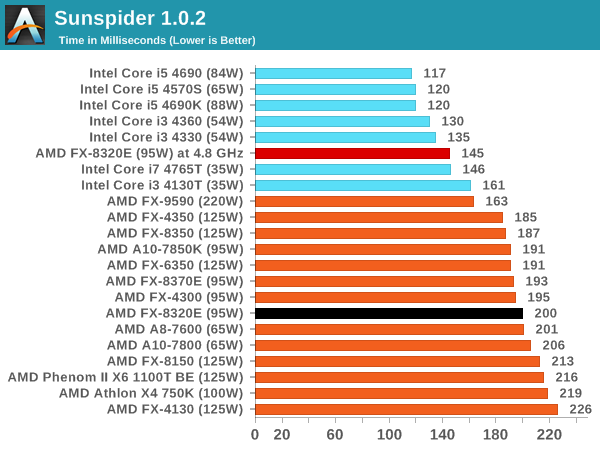
Mozilla Kraken 1.1
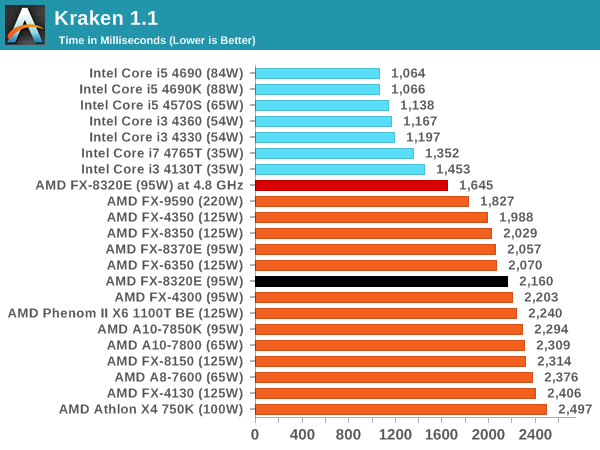
WebXPRT
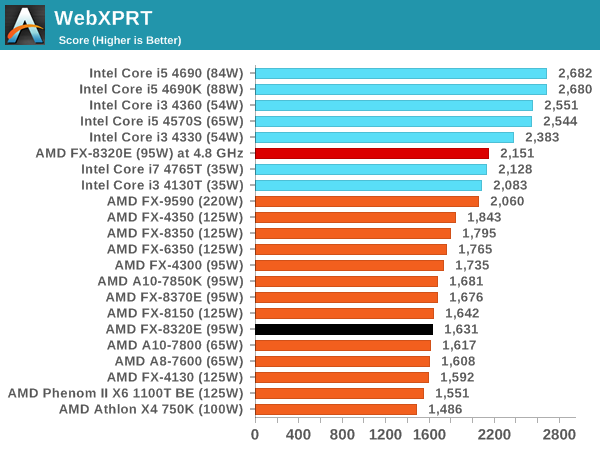
Google Octane v2
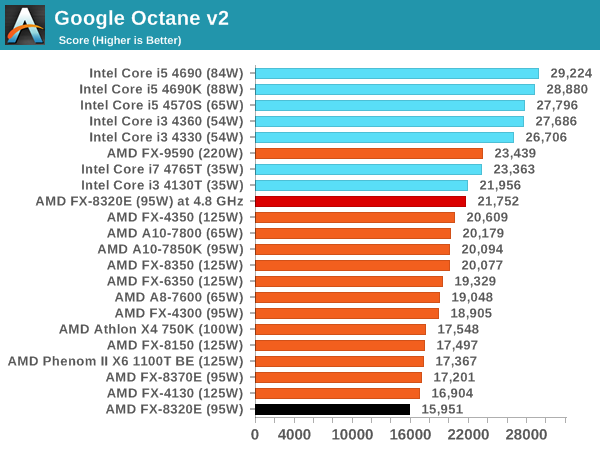










92 Comments
View All Comments
Kevin G - Tuesday, January 13, 2015 - link
Updating the chipset is necessary to get new IO on to a platform. Things like USB 3.0 can then be integrated into the chipset so that a 3rd party controller is no longer needed.Rather the nice thing is that AMD hasn't changed socket in 5 years with AM3+. Intlel on the other hand has had three sockets of chips with dual channel DDR3, 16 PCIe lanes and DMI to the chipset. Sure, a few things changed between socket 1156, 1155 and socket 1150, but it would have been nice if Intel was forward thinking and maintained compatibility. The quad core Lynfield chips are still respectable in terms of CPU performance today.
Penti - Tuesday, January 13, 2015 - link
They has basically frozen their whole platform with the failed Bulldozer release. Their chipset's hasn't changed much since AM2+/AM3 days, the NB is basically the same as the 2007 790FX. The only thing 990FX added over 790FX is probably the IOMMU-support (and updated the PCIe lanes used by the SB to PCIe 2.0 also called A-link Express) which was first found in the identical 890FX, also IOMMU was found in server chipsets built on the 800-series back in '10. The southbridge on AM3+ hasn't changed since launch and is basically the same as the 2010 SB850. It's planned that they have a 4 year or so gap. They canceled a lot of designs and plans. Including new server socket and server chipset. They scrapped the plans for new BD chips for AM3+/successor socket also which is why you have no Steamroller or Excavator, and why you have no 10/20-core 2-gen Bulldozer/Piledriver for servers. So the chipset is really 5 years old and based on the same tech as 7 year old NB built on the same process and had HT3 support back then too. So the NB is really 2007-era with minor changes, SB has no USB3 support.Intel basically did have a platform which didn't get a chipset update for ~3 years – the X79. That wasn't such a good deal thanks to no native USB3 support, few SATA6 ports and so on. Lots of bugs too.
stefantalpalaru - Tuesday, January 13, 2015 - link
Here are a series of benchmarks I did on the same (rather modest) motherboard with a Phenom II X6 at 3.9 GHz and the FX-8320E at stock frequency and a 4.5 GHz overclock: http://openbenchmarking.org/result/1412036-KH-MERG...mikato - Wednesday, January 14, 2015 - link
Very cool! Thanks for this. If I interpret the colors correctly, it looks like the X6 wins mostly, but when the FX-8320E is overclocked, it wins mostly.LarsBars - Saturday, January 17, 2015 - link
I used some of the sorting tools and it looks like your summary is correct.But keep in mind that the Phenom II X6 is overclocked... so it's kind of hard to draw conclusions from it. I guess it would have made sense if it was stock vs stock (which we sort of already have in the AT article) or OC vs OC (since AT didn't OC an X6).
$0.02
SpaceRanger - Tuesday, January 13, 2015 - link
The only graph that I wanted to see was the power consumption graph, and it's not included.. :(I really wanted to see just how much they chopped off the power consumption with this go-around.
silverblue - Tuesday, January 13, 2015 - link
Toms benched the 8370E and appeared to get some very interesting power readings. Though this doesn't necessarily ring true for the 8320E, it may be helpful nonetheless:http://www.tomshardware.com/reviews/amd-fx-8370e-c...
sonicmerlin - Tuesday, January 13, 2015 - link
The most painful aspect of AMD's single threaded performance woes is that Intel hasn't even bothered with increasing IPC since Sandy Bridge. AMD needs their new architecture to be a smash hit if they want to avoid bankruptcy.silverblue - Tuesday, January 13, 2015 - link
And that's what bothers me about Carrizo not coming to the desktop. We don't know if that 30% IPC boost is across the board or mainly as a result of FPU gains, but at the very least, Carrizo should bury Phenom II and previous Bulldozer designs, and at least equal Lynnfield/Nehalem, at the same clocks but for far lower power consumption. Still, performance wise, it's not exactly a lofty goal - you'd need more than four cores for that.xenol - Tuesday, January 13, 2015 - link
Software most people use didn't take advantage of Bulldozer because they weren't multi-threaded. It's because software most people use don't take advantage of CPU performance period. Most of the programs in your task manager idle.Modern software is multi-threaded, as in, they have multiple threads. And all the major OSes (Windows, Linux, Mac OS X) schedule at the thread level on any available resource. If they don't take advantage of multiple cores, it's not because they are "single threaded", it's because what they do isn't very taxing for a CPU to do.